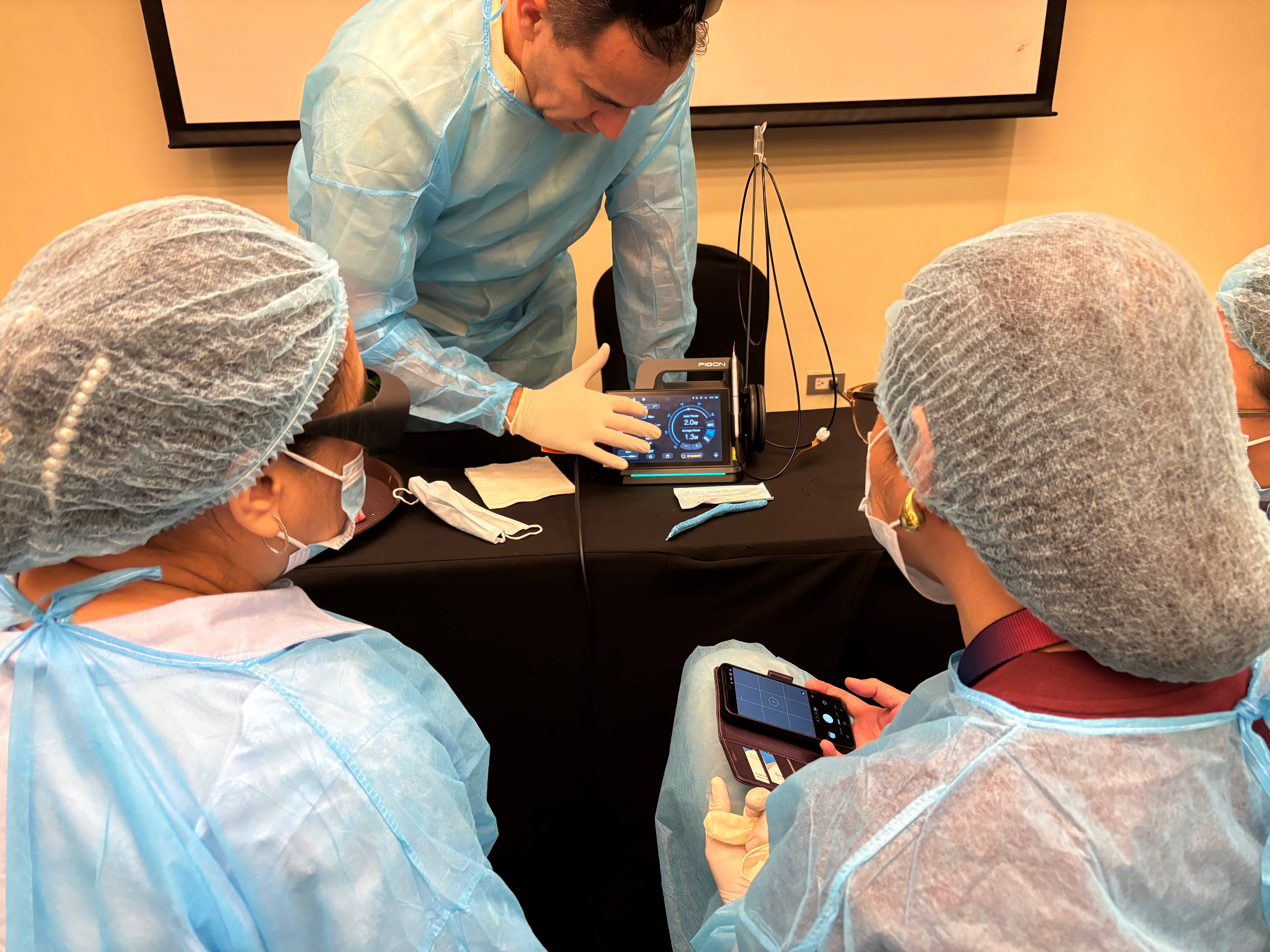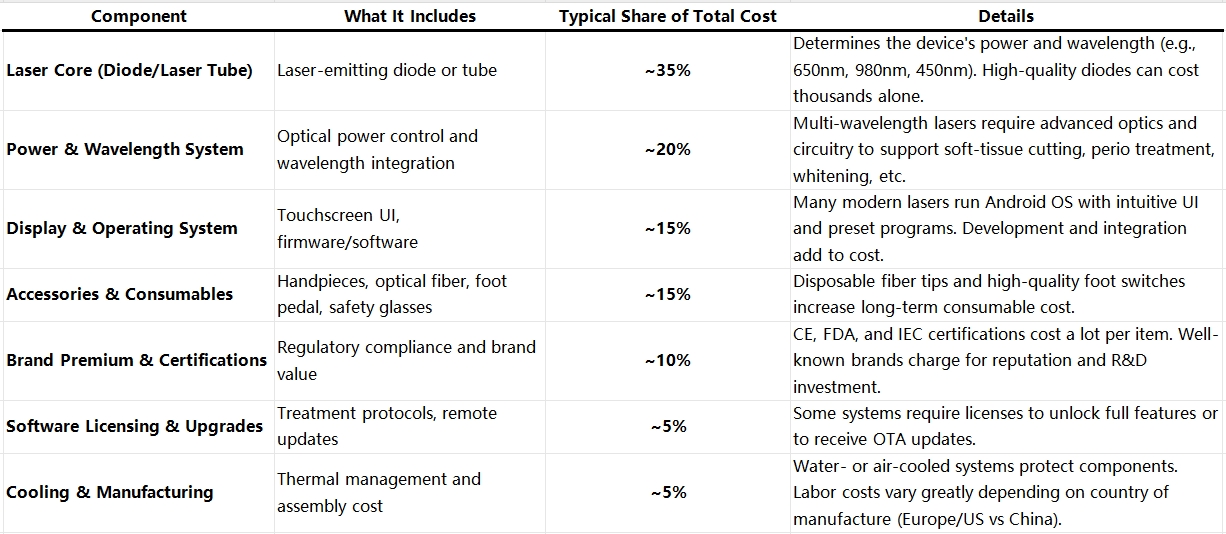
Dental Laser Price vs Performance: What Really Matters for Distributors and Buyers?
Is Higher Price Always Better?
In today's rapidly evolving dental equipment market, dental diode lasers are no longer niche tools — they are becoming essential for modern practices. However, with prices ranging from a few hundred to several thousand dollars, buyers and distributors often face a common dilemma: “Should I go for the most expensive model, or will a cost-effective one do the job just as well?”
This article aims to unpack the real value behind the price tag and help you understand what truly matters when evaluating dental laser devices, beyond just cost.
What Are You Actually Paying For?
Not all dental diode lasers are priced the same, and there's a reason for this. Below is a breakdown of the typical components that contribute to the total cost of a dental laser device. Understanding these components helps buyers and distributors evaluate whether they are paying for value or brand markup.

Note: These percentages are approximate and may vary depending on brand, configuration, and sourcing strategy. However, they provide a useful framework for comparing values across products.
Data resource:
· Cost Proportions:
Based on general estimations within the medical device industry, referencing the gminsights report, "Dental Lasers Market" https://www.gminsights.com/industry-analysis/dental-laser-market.
· Certification Costs:
FDA official website (https://www.fda.gov/industry/fda-user-fee-programs/medical-device-user-fee-amendments-mdufa-fees) and EU CE certification guidelines.
· Pricing and Components:
MedicalExpo product list (www.medicalexpo.com), listing 107–122 types of dental laser equipment.
A well-priced laser isn't "cheap" — it's streamlined. It focuses on essential features and offers reliable performance with minimal extras.
Performance That Actually Impacts Daily Use
The user experience and clinical efficiency of dental laser equipment significantly influence operator performance and patient satisfaction. Below is a detailed breakdown of key functions:
1. Quick Startup and Preset Programs: Preset treatment protocols (e.g., periodontal therapy, whitening) reduce setup time and learning curves, ideal for novice clinicians. Fast startup minimizes patient wait times.
2. Foot Pedal Sensitivity and Wireless Connectivity: Highly responsive foot pedals ensure precise control, while wireless connectivity (e.g., Bluetooth) eliminates cable clutter, enhancing operational flexibility. Connection reliability is critical.
3. Portability: Equipment weight (portable units 2–10 kg) and battery life (4–8 hours) affect mobility. Carrying case designs facilitate transport between clinics, suiting multi-location practitioners.
4. Multilingual Support and Video Guidance: Multilingual interfaces (e.g., English, Chinese) and instructional videos lower training barriers, benefiting international or new users.
5. Ergonomics and User Interface: Lightweight handpieces (200–300g) and intuitive touchscreens (e.g., Android-based) reduce fatigue and boost efficiency.
6. Treatment Versatility: Seamless switching between procedures (e.g., soft tissue cutting, periodontal treatment) without recalibration increases patient throughput.
7. Safety Features and Software Integration: Auto-power adjustment and overheat protection enhance safety. Integration with practice management software streamlines record-keeping and billing.
Remember: Your staff's ability to use the laser effectively is more valuable than any technical spec on paper.
Common Price vs Performance Myths
Misconceptions about dental laser equipment can mislead buyers, affecting purchasing decisions. Below, we debunk key myths with added insights:
Myth 1: The More Expensive, the Better
High-priced lasers do not always guarantee superior outcomes. Premium brands like Biolase or Fotona often charge for brand recognition, sleek designs, or extensive marketing, not necessarily clinical efficacy. Mid-range models can match performance for standard procedures like soft tissue surgery, saving costs without compromising quality.
Myth 2: Higher Power Equals Better Results
Many believe that higher-powered dental lasers (e.g., >7W) deliver superior outcomes. However, excessive power can harm tissues, causing thermal damage or delayed healing. In clinical practice, moderation is key. Precision control and application-specific settings (e.g., 1–3W for periodontal therapy) are more critical for optimal results. Selecting super-pulsed dental lasers enhances precision by delivering energy in ultra-short pulses, minimizing heat buildup, and reducing collateral tissue damage.
Myth 3: Certifications Guarantee Reliability and Performance
While CE or FDA certifications ensure regulatory compliance, they do not necessarily reflect a dental laser's clinical performance, longevity, or build quality. Some certified low-end models may meet minimum standards but lack durability or consistent output, leading to suboptimal results or frequent maintenance. Evaluating manufacturer reputation, user reviews, and long-term performance data is essential to ensure reliability beyond certifications.
Myth 4: Advanced Features Are Essential for All Clinics
Features like wireless connectivity, touch-screen interfaces, or sophisticated software may sound appealing, but are often unnecessary for practices focused on routine procedures like gingivectomy or caries removal. Simpler, reliable models with core functionalities can meet the needs of most clinics, reducing costs and minimizing the learning curve for staff. Clinics should prioritize features that align with their specific treatment goals.
How to Evaluate the True Value of a Dental Laser Device
When investing in a dental laser, the true value goes far beyond just the price tag or wattage. A wise choice should be based on long-term usability, clinical effectiveness, and total cost of ownership. Below the table, we expand on key dimensions to help you make an informed decision.
Don't Just Look at the Device – Evaluate the Ecosystem
Evaluation Dimension |
Questions |
Why It Matters |
| Clinical Application Fit | Does it support your most frequent procedures (e.g., soft tissue, perio, endo, surgery)? |
Avoid paying for features you don't need, or missing those you do. |
| Treatment Protocols | Are there built-in presets for common treatments? | Saves time, ensures consistency, and eases training for new users. |
| Durability & Maintenance | Is the device known for stability? How often does it require calibration or service? | A cheap device with high maintenance quickly becomes costly. |
| After-sales Support | Are clinical training, technical support, and spare parts available locally? | Poor support means downtime and frustrated staff. |
| Software & Upgrades | Does the system allow firmware updates, new protocols, or remote troubleshooting? |
A future-proof system evolves with your practice. |
| Accessories & Consumables | Are fiber tips, handpieces, and goggles reasonably priced and easy to reorder? | Hidden costs often lie in the consumables. |
From a Distributor's View: What Makes a Dental Laser Easy to Sell?
Distributors prioritize dental lasers that align with clinical demands, streamline sales processes, and support long-term customer satisfaction. Below are the key factors that make a dental laser appealing to distribute, based on market trends and practical considerations.
Broad Clinical Applications
Versatile lasers supporting soft tissue surgery, periodontal therapy, endodontics, and whitening (e.g., 810–980 nm diode lasers) appeal to diverse practices, maximizing market reach.
Ease of Demonstration
Intuitive interfaces and visible results (e.g., precise cutting, minimal bleeding) simplify in-clinic demos. Compact, portable designs (under 5 kg) enhance appeal.
Global Certifications
CE, FDA, or ISO 13485 certifications ensure compliance across markets like North America and Europe, streamlining international sales.
Strong Marketing Support
Manufacturer-provided brochures, clinical videos, and training webinars equip distributors to engage buyers effectively.
Low Learning Curve
Lasers with pre-set protocols (e.g., 1.5–2W for gingivectomy) and simple controls accelerate clinician adoption.
Reliable After-Sales Support
Prompt technical support, spare parts availability, and 2–3-year warranties build buyer confidence and reduce distributor risk.
Why Value Trumps Cost
Price alone doesn't define a dental laser's worth. Mid-range models ($5,000–$15,000) often dominate sales (60% market share in 2023) due to their affordability and reliability. Distributors and buyers should evaluate:
Clinical Fit: Does it address core procedures like soft tissue or bacterial reduction?
Support System: Are training and maintenance accessible?
Growth Potential: Can it expand services, like laser whitening, to boost revenue?
Conclusion: Strategic Selection Drives Success
Choosing a dental laser requires balancing clinical efficacy, operational simplicity, and economic viability. Distributors succeed by promoting devices that meet diverse practice needs, are backed by strong manufacturer support, and deliver measurable value to clinicians. By focusing on these factors, distributors can build trust with customers, close deals efficiently, and foster long-term business growth.
